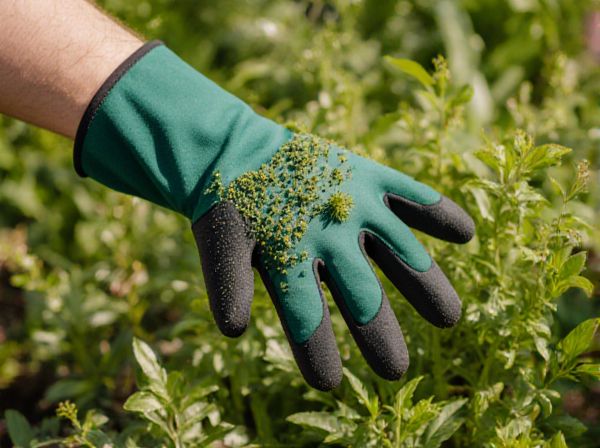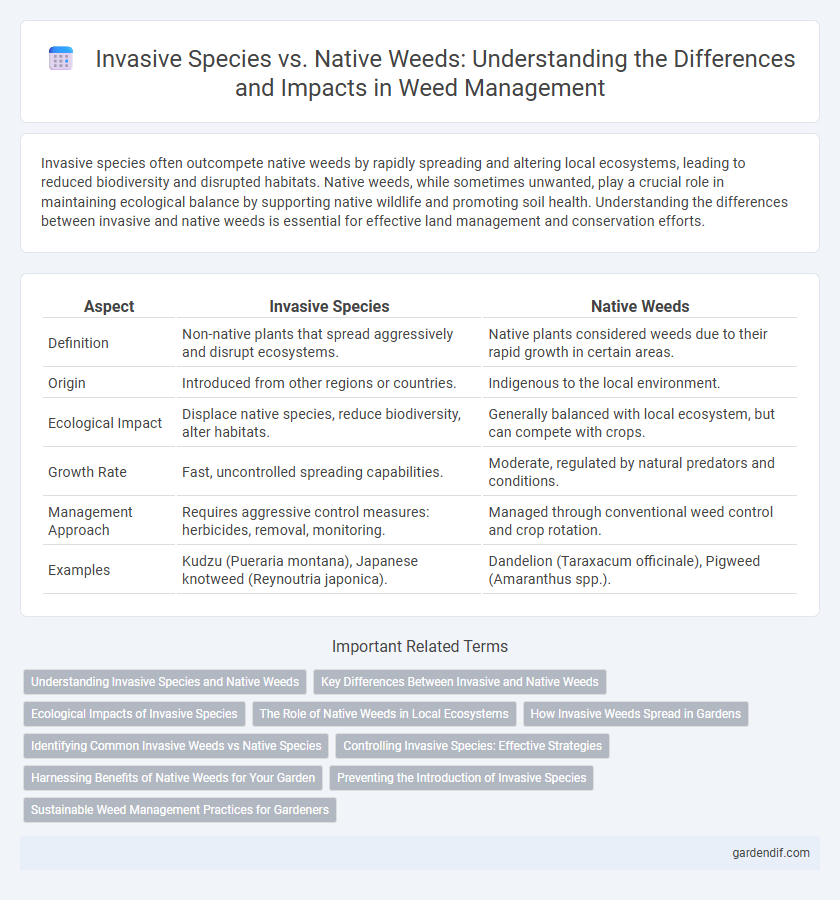
Invasive species vs Native weeds Illustration
Invasive species often outcompete native weeds by rapidly spreading and altering local ecosystems, leading to reduced biodiversity and disrupted habitats. Native weeds, while sometimes unwanted, play a crucial role in maintaining ecological balance by supporting native wildlife and promoting soil health. Understanding the differences between invasive and native weeds is essential for effective land management and conservation efforts.
Table of Comparison
| Aspect | Invasive Species | Native Weeds |
|---|---|---|
| Definition | Non-native plants that spread aggressively and disrupt ecosystems. | Native plants considered weeds due to their rapid growth in certain areas. |
| Origin | Introduced from other regions or countries. | Indigenous to the local environment. |
| Ecological Impact | Displace native species, reduce biodiversity, alter habitats. | Generally balanced with local ecosystem, but can compete with crops. |
| Growth Rate | Fast, uncontrolled spreading capabilities. | Moderate, regulated by natural predators and conditions. |
| Management Approach | Requires aggressive control measures: herbicides, removal, monitoring. | Managed through conventional weed control and crop rotation. |
| Examples | Kudzu (Pueraria montana), Japanese knotweed (Reynoutria japonica). | Dandelion (Taraxacum officinale), Pigweed (Amaranthus spp.). |
Understanding Invasive Species and Native Weeds
Invasive species disrupt ecosystems by outcompeting native weeds, leading to reduced biodiversity and altered habitats. Native weeds, adapted to local conditions, play essential roles in supporting wildlife and maintaining soil health. Effective management requires distinguishing invasive plants from native weeds to protect ecological balance and promote sustainable land use.
Key Differences Between Invasive and Native Weeds
Invasive weeds are non-native plants that rapidly spread and disrupt local ecosystems, often outcompeting native species for resources like nutrients, sunlight, and water. Native weeds are indigenous to the region and typically exist in ecological balance, supporting local biodiversity without causing significant harm. Key differences include the origin of species, impact on biodiversity, and control management strategies tailored to prevent ecological damage caused by invasive weeds.
Ecological Impacts of Invasive Species
Invasive species disrupt native ecosystems by outcompeting native weeds for resources, leading to reduced biodiversity and altered habitat structures. These species often lack natural predators, allowing unchecked growth that destabilizes soil composition and nutrient cycles. Their aggressive expansion can cause declines in native plant populations and negatively impact wildlife dependent on indigenous vegetation.
The Role of Native Weeds in Local Ecosystems
Native weeds play a crucial role in local ecosystems by supporting biodiversity through providing habitat and food sources for native insects, birds, and other wildlife. These plants contribute to soil health by preventing erosion and enhancing nutrient cycling, maintaining ecosystem resilience. Unlike invasive species, native weeds are well integrated into ecological processes, promoting stability and balance within their native environments.
How Invasive Weeds Spread in Gardens
Invasive weeds spread rapidly in gardens through wind-dispersed seeds, water runoff, and human activities such as gardening tools and soil movement. These species often outcompete native weeds by establishing extensive root systems and releasing allelopathic chemicals that inhibit other plants' growth. Their aggressive colonization disrupts local ecosystems, reducing biodiversity and altering soil composition.
Identifying Common Invasive Weeds vs Native Species
Invasive weeds such as kudzu (Pueraria montana) and Japanese knotweed (Fallopia japonica) aggressively outcompete native species like goldenrod (Solidago spp.) and milkweed (Asclepias spp.), disrupting local ecosystems. Identifying common invasive weeds involves recognizing their rapid growth, extensive root systems, and ability to dominate habitats, while native weeds typically coexist without drastically altering biodiversity. Accurate differentiation is critical for effective management and restoration of native plant communities.
Controlling Invasive Species: Effective Strategies
Controlling invasive species requires an integrated management approach combining mechanical removal, targeted herbicide application, and biological control agents to reduce their spread and impact. Early detection and continuous monitoring enable prompt intervention, preventing invasive weeds from outcompeting native species and disrupting ecosystems. Restoration efforts with native plants help stabilize habitats, enhancing biodiversity and resilience against future invasions.
Harnessing Benefits of Native Weeds for Your Garden
Native weeds play a crucial role in supporting local biodiversity by providing habitat and food sources for pollinators and beneficial insects. These plants improve soil health through natural nutrient cycling and can act as natural ground cover, reducing erosion and retaining moisture. Harnessing the benefits of native weeds in your garden promotes ecological balance while minimizing the challenges posed by invasive species that disrupt local ecosystems.
Preventing the Introduction of Invasive Species
Preventing the introduction of invasive species requires strict biosecurity measures, including cleaning equipment and monitoring imported plants to avoid contamination. Native weeds, while often competitive, typically support local ecosystems and biodiversity, unlike invasive species that disrupt habitats and outcompete native flora. Early detection and rapid response strategies are critical to controlling invasive weed spread and protecting native plant communities.
Sustainable Weed Management Practices for Gardeners
Sustainable weed management practices for gardeners emphasize the importance of identifying invasive species versus native weeds to maintain ecological balance. Invasive species, such as Japanese knotweed or kudzu, often outcompete native plants and disrupt local ecosystems, requiring targeted control methods like manual removal or organic herbicides. Native weeds, while sometimes competing with desired plants, generally support local biodiversity and can be managed through mulching, crop rotation, and promoting healthy soil biology.
Invasive species vs Native weeds Infographic

 gardendif.com
gardendif.com